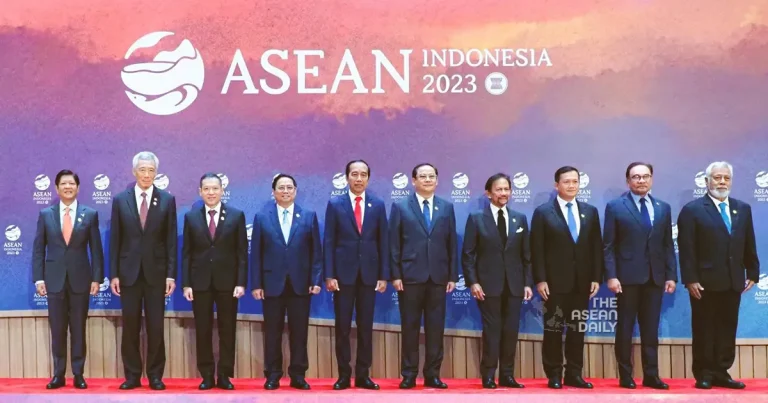13-9-2023 (JAKARTA) At the recent Association of Southeast Asian Nations (ASEAN) Summit in Jakarta, Singapore’s Prime Minister Lee Hsien Loong passionately spoke about ASEAN’s need for “unity of purpose and action” when facing challenges, both external and internal.
While acknowledging the divergent interests and positions among ASEAN member states regarding pressing geopolitical issues, Mr Lee urged his fellow leaders to collectively “work towards common landing points”, a process likely requiring “some give and take” between themselves.
Mr Lee’s plea comes at a critical time. ASEAN faces ongoing difficulties regarding Myanmar, heightened regional tensions, and the fast-entrenching Indo-Pacific infrastructure that could sideline ASEAN in regional affairs if left unattended.
It also signals concern over ASEAN’s fortunes as the bloc transitions from Indonesia’s strong leadership to the potentially weak incoming chairmanship of Laos.
Good is Not Enough
To seasoned ASEAN observers, Mr Lee’s call for institutional unity and proactivity – key to ensuring ASEAN’s continued relevance in an increasingly fraught Indo-Pacific – is a common refrain, often for the wrong reasons.
While ASEAN’s intramural diplomacy has maintained peace among its member states for over five decades, that same consensus-based decision-making model on which ASEAN relies, limits its ability to positively impact members’ internal affairs when needed.
With the right conditions, ASEAN’s brand of moral suasion works wonderfully – as in 2008, when ASEAN successfully convinced Myanmar’s then-ruling junta to accept international aid following Cyclone Nargis’ devastation.
However, faced with today’s obdurate Naypyidaw leadership and internal disunity, ASEAN has failed to bring the current junta in line with the Five Point Consensus agreed with its leader Min Aung Hlaing in April 2021.
Externally, despite assurances of support from the United States and China at the ASEAN Summit, their intensifying rivalry compels Southeast Asian nations to take sides – something they wish to avoid.
Furthermore, ASEAN struggles to argue its relevance to the ascendant Indo-Pacific paradigm through which foreign policymakers now view Asia.
In recent years, frameworks like China’s Belt and Road Initiative and US-backed arrangements such as the Quad, AUKUS and Indo-Pacific Economic Framework have proliferated. These are seen by some as rival architectures that threaten to diminish ASEAN’s vaunted “centrality” in regional affairs.
Time to Step Up
Against this difficult backdrop, ASEAN must step up or risk losing relevance. The flux in the Indo-Pacific offers opportunities for ASEAN to seize.
Granted, US-China relations are likely to deteriorate further. China also angered the region anew with its latest national map laying claims from the Himalayas to the South China Sea, eliciting objections from India, Malaysia, the Philippines, Taiwan and Vietnam – all with territorial disputes against China.
Yet with its current economic woes, it is uncertain whether a weaker China will continue dominating ASEAN with its divide-and-rule tactics. Nor is it clear whether China’s expected slowdown, negatively impacting Southeast Asia, may sufficiently relax its economic hold to encourage countries like Cambodia and Laos to ease their pro-China stances.
If ASEAN is to “be the captain of its own ship”, as Indonesian President Joko Widodo emphasised when handing over the chairmanship to Laos’ Sonexay Siphandone, a less Beijing-beholden Laos could help.
In this respect, Laos’ consent to ASEAN’s “troika” approach – comprising Laos, Indonesia and Malaysia in 2024 – to deal with Myanmar is a positive sign Vientiane seeks a collective solution.
In calling for greater unity, commonality and flexibility, Mr Lee urges ASEAN to walk its talk of regional leadership – a privilege that can no longer be taken for granted as outsiders contest, redraw and redefine the region.
In his ASEAN address, Mr Lee spoke at length about the ASEAN Outlook on the Indo-Pacific, the bloc’s official response claiming “a central and strategic role” in the region. Yet there can be no substance without conduct to back it up.
In a 2015 speech, former Singaporean diplomat Bilahari Kausikan chastised academics for wrongly expecting ASEAN to behave as a “horse”, when it is but a “cow”.
Partly because of ASEAN’s penchant for “horse talk”. Whether cow or horse, it is time for ASEAN to pull its weight, or risk failing through its own doing.




